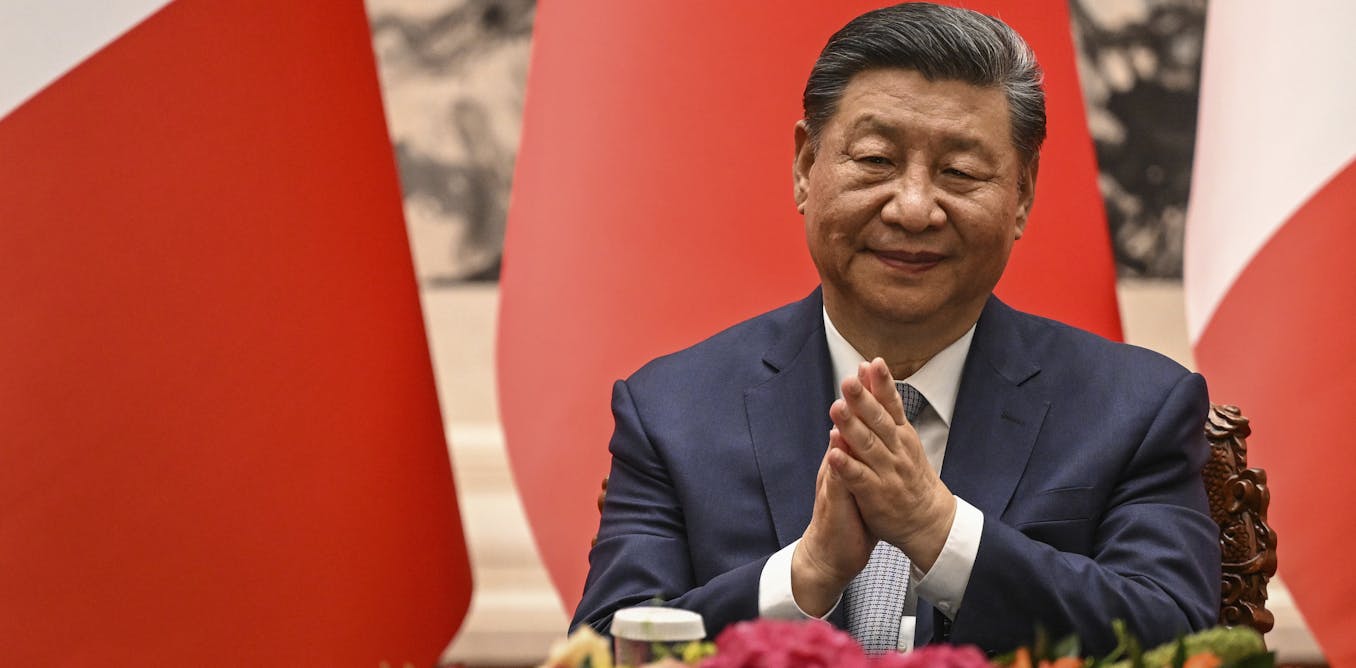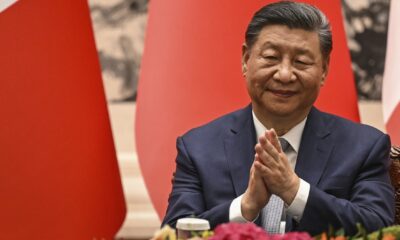China
Chinese lawfare, resource disputes and the law of the sea

Author: Douglas Guilfoyle, UNSW Canberra
China notoriously claims special maritime rights in the South China Sea within the ‘nine-dash line’ that appears on official Chinese maps. The precise origin of the line remains obscured. The ‘nine-dash line’ did not appear on government maps prior to 1947 or in private cartographic exercises before 1933. As late as 2013, prominent Chinese scholars accepted that China had never expressly articulated the line’s legal significance.
Recent Chinese claims to exclusive jurisdiction over resources within it have escalated tensions not only over oil but also over exploited and declining fish stocks ‘fundamental to the food security of coastal populations numbering in the hundreds of millions’. But China’s legal argument about the South China Sea should be seen both in its historical context and in light of China’s doctrine on information warfare.
Law plays an important role in the dispute over the nine-dash line because the line cuts deep into what various coastal states including Vietnam and the Philippines regard as their 200 nautical mile Exclusive Economic Zone (EEZ) under the UN Convention on the Law of the Sea (UNCLOS). Ironically, in the marathon negotiations that lead to UNCLOS, China was a principal advocate of the EEZ concept, aligning itself with developing countries against Russia and the United States.
It is useful to review the issues that were of fundamental concern to China in the UNCLOS negotiations. These are documented in Chinese working papers submitted to the UN Seabed Committee in the early 1970s and in speeches China made during the negotiation process.
China advocated for five main positions. First, that there was no fixed maximum width to the territorial sea — the extent of a state’s maritime domain was a sovereign decision to be informed by economic and security needs. Second, warships had no automatic right of innocent passage through territorial seas and straits. Third, China’s own Chiungchow Strait and vast Bohai Bay had a special status as ‘internal waters’. Fourth, that maritime boundaries should be settled only by consultation and UNCLOS should make no provision for the judicial settlement of such disputes. Fifth, a continental state with sovereignty over an outlying archipelago could draw straight baselines around it and use these to measure a territorial sea.
Notably, though China expressly claimed a special status for some waters it never did so for the South China Sea. China maintained its Chiungchow Strait and Bohai Bay claims throughout negotiations, along with its position on warships and innocent passage. But Beijing abandoned its position on the width of the territorial sea and on ‘outlying archipelagos’. This history shows that China’s recent supposed enjoyment of ‘special historic rights’ within the nine-dash line is the product of a very new legal claim.
A major blow to the Chinese position in favour of coastal states enjoying their ‘ordinary’ EEZs came in the Philippines v China arbitration. Since then, the Chinese government has pivoted back to a version of the ‘outlying archipelago’ argument previously abandoned during UNCLOS negotiations, an argument revived in the Chinese Society of International Law’s ‘critical study’ of the Philippines v China arbitral award. China now claims it can bundle up various maritime features into ‘archipelagos’, enclose them in straight baselines and project EEZs from them.
The argument is both historically revisionist and legally unconvincing. However, in addition to the creation of EEZ claims, re-characterising certain features as islands or archipelagos allows China to claim US warships are constrained in navigating near such features. The United States maintains that such features are not capable of generating territorial seas and that it is exercising freedom of navigation applicable in an EEZ or on the high seas. But why is China bothering to make such arguments at all?
The Chinese Communist Party (CCP) appreciates the power of law. Its ‘three warfares’ doctrine outlines a triad of non-kinetic methods for achieving China’s national goals: public opinion warfare, psychological warfare and legal warfare. Among these, the function of legal warfare (‘lawfare’) is explained by Livermore as ‘leveraging of existing legal regimes and processes to constrain adversary behaviour, contest disadvantageous circumstances, confuse legal precedent, and maximise advantage in situations related to the PRC’s core interests’.
The function…
China
Italy and China New DTA Set to Take Effect in 2025: Important Changes and Implications

Italy ratified an upgraded Double Tax Agreement (DTA) with China, effective in 2025, to reduce tax burdens, prevent evasion, and enhance investment. The DTA introduces modern provisions aligned with international standards, targeting tax avoidance and improving dispute resolution for Italian businesses.
Italy recently ratified the upgraded Double Tax Agreement (DTA), which will finally take effect in 2025. This agreement was signed in 2019 and was designed to reduce tax burdens, prevent tax evasion, and promote Italian investment in China.
On November 5, 2024, Italy’s Chamber of Deputies gave final approval to the ratification of the 2019 Double Tax Agreement (DTA) between Italy and China (hereinafter, referred to as the “new DTA”).
Set to take effect in 2025, the new DTA is aimed at eliminating double taxation on income, preventing tax evasion, and creating a more favorable environment for Italian businesses operating in China.
The ratification bill for the new DTA consists of four articles, with Article 3 detailing the financial provisions. Starting in 2025, the implementation costs of the agreement are estimated at €10.86 million (US$11.49 million) annually. These costs will be covered by a reduction in the special current expenditure fund allocated in the Italian Ministry of Economy’s 2024 budget, partially drawing from the reserve for the Italian Ministry of Foreign Affairs.
During the parliamentary debate, Deputy Foreign Minister Edmondo Cirielli emphasized the new DTA’s strategic importance, noting that the agreement redefines Italy’s economic and financial framework with China. Cirielli highlighted that the DTA not only strengthens relations with the Chinese government but also supports Italian businesses, which face increasing competition as other European countries have already established double taxation agreements with China. This ratification, therefore, is part of a broader series of diplomatic and economic engagements, leading up to a forthcoming visit by the President of the Italian Republic to China, underscoring Italy’s commitment to fostering bilateral relations and supporting its businesses in China’s complex market landscape.
The newly signed DTA between Italy and China, introduces several modernized provisions aligned with international tax frameworks. Replacing the 1986 DTA, the agreement adopts measures from the OECD/G20 Base Erosion and Profit Shifting (BEPS) Project and the OECD Multilateral Instrument (MLI), targeting tax avoidance and improving dispute resolution.
The Principal Purpose Test (PPT) clause, inspired by BEPS, is one of the central updates in the new DTA, working to prevent treaty abuse. This clause allows tax benefits to be denied if one of the primary purposes of a transaction or arrangement was to gain a tax advantage, a move to counter tax evasion through treaty-shopping.
| This article was first published by China Briefing , which is produced by Dezan Shira & Associates. The firm assists foreign investors throughout Asia from offices across the world, including in in China, Hong Kong, Vietnam, Singapore, and India . Readers may write to info@dezshira.com for more support. |
Read the rest of the original article.
Business
China’s New Home Prices Stabilize After 17-Month Decline Following Support Measures

China’s new home prices fell for the 17th month in October, declining 0.5% from September, but slowing, indicating potential market stabilization amid supportive measures. Second-hand home prices showed mixed trends.
Decline in China’s Home Prices Stabilizes
China’s new home prices continued to decline in October for the 17th consecutive month, although the drop showed signs of slowing. Recent support measures from Beijing appear to be inching the market toward stabilization, as evidenced by a lighter decline compared to earlier months.
Monthly and Yearly Comparisons
According to the latest data from the National Bureau of Statistics, new home prices across 70 mainland cities fell by 0.5% from September, marking the smallest decrease in seven months. Year-on-year, prices dropped by 6.2%, slightly worse than the September decline of 6.1%. In tier-1 cities like Beijing and Shanghai, prices decreased by 0.2%, a smaller fall than 0.5% in the previous month.
Second-Hand Home Market Trends
Second-hand home prices in tier-1 cities experienced a 0.4% increase in October, reversing a 13-month downward trend. Conversely, tier-2 cities observed a 0.4% drop in second-hand prices, while tier-3 cities faced a similar 0.5% decline. Overall, recent trends indicate a potential stabilization in China’s property market.
Source : China’s new home prices slow 17-month decline after support measures kick in
China
U.S. national debt is its Achilles’ heel, but China sees it as an opportunity

China is emerging as a dominant force in the Global South, challenging U.S. dollar hegemony by increasing gold reserves and reducing U.S. debt holdings, aiming for a multipolar economic landscape.
China is gradually establishing itself as a major player in what has recently been called the Global South, previously known as the Non-Aligned Movement. Over the last few decades, China has become the world’s biggest creditor of developing countries. That has prompted many to fear that it will subjugate partners through the “debt trap” and use this to establish a “hegemonic sphere of influence.”
China’s economic position is so strong that it is now considered the main threat to the U.S. dollar. It is an influential member of the BRICS+ group (which also includes Brazil, Russia, India and South Africa). This group is working to establish a multipolar world that challenges the hegemony of the West, specifically the leadership of the United States. I analyzed this issue in a previous article.
Without using the term “threat,” the U.S. administration now sees China as the “most serious long-term challenge” to the international order. It’s easy to understand why, since China’s strategic objective is to put an end to the supremacy of the U.S. dollar, the keystone of U.S. hegemony.
As a researcher in international political economy at the Université Laval, I am looking at the role China is playing in the dedollarization of the world.
The stronghold of the U.S. dollar
The supremacy of the U.S. dollar underpins American hegemony in the current international order, as French economist Denis Durand explains in his article Guerre monétaire internationale: l’hégémonie du dollar contestée? (International currency war: the dollar’s hegemony challenged?).
In addition to the fact that several currencies are linked to the dollar by a fixed link or band of fluctuation, American currency is also used in many Third World and Eastern European countries, where it enjoys a much higher level of public confidence than do local currencies. […] The United States is the only power that can incur foreign debt in its own currency.
The hegemony of the U.S. dollar over the world economy is reflected in its over-representation in the foreign exchange reserves held by the world’s central banks. The greenback still outstrips other currencies even though there has been some erosion in this.
Despite a fall of 12 percentage points between 1999 and 2021, the share of the U.S. dollar in the official assets of the world’s central banks remains fairly stable at around 58-59 per cent.
U.S. currency still enjoys widespread confidence around the world, reinforcing its status as the preeminent reserve currency. The U.S. dollar reserves of the world’s central banks are invested in U.S. Treasury bills on the U.S. capital market, helping to reduce the cost of financing both government debt and private investment in the United States.
However, the income generated for the U.S. economy by the hegemony of its dollar could also collapse like a house of cards. Durand makes this point when he writes that “the monetary hegemony of the United States […] is held together only by the confidence of economic agents around the world in the American dollar.”
There are two reasons that the world’s confidence in the U.S. dollar could decrease.
Firstly, as U.S. Treasury Secretary Janet Yellen admitted in an interview in April 2023, the United States is unequivocally using its dollar as a tool to bend enemies — but also some recalcitrant allies — to its will. This could ultimately undermine the dollar’s hegemony.
On the other hand, the U.S. debt situation, particularly its unsustainability, is a source of concern that could affect the dollar’s attractiveness as a global reserve currency.
Unsustainable debt
The U.S. dollar has been at the heart of the international monetary system since 1944, and even more so since the Bretton Woods Agreement came into force in 1959.
The Bretton Woods system was based on both gold and the greenback, which was the only currency convertible into gold; this convertibility was fixed at the rate of $35 per ounce.
That changed on Aug. 15, 1971, when, because of inflation and the growing imbalances in the United States’ international economic relations, Richard Nixon announced the end of the dollar’s convertibility into gold.
With the dollar pegged to gold, the United States’ ability to take on debt to meet public spending was limited. Under the gold-based system, where gold was the guarantor of the U.S. currency, the United States could only borrow according to the quantity of dollars in circulation and its gold reserves.
Abandoning the gold-based system gave the U.S. free rein over its debt. In 2023, the U.S. public debt reached more than $33.4 trillion, nine times the country’s debt in 1990.
This astronomical figure continues to raise concerns about its long-term sustainability. As U.S. Federal Reserve Chairman Jerome Powell has pointed out, U.S. debt is growing faster than the economy, making it unsustainable in the long term.
An opportunity for China
This is a reality to which China is clearly attuned, since it recently undertook a massive sell-off of the U.S. debt it owned. Between 2016 and 2023, China sold $600 billion worth of U.S. bonds.
However, in August 2017 China was the United States’ largest creditor, ahead of Japan. It held more than $1.146 billion in U.S. Treasuries, almost 20 per cent of the amount held by all foreign governments. Beijing is now the second-largest foreign holder of U.S. debt, with a claim of around $816 billion.
It is certainly no coincidence that before divesting itself of U.S. bonds, Beijing first launched its own gold pricing system in yuan. In fact, on April 19, 2016, the Shanghai Gold Exchange, China’s operator for precious metals, unveiled on its website its first “fixed” daily benchmark for gold at 256.92 yuan per gram.
This policy is part of China’s strategy to make gold a tangible guarantee of its currency.
China’s “Gold for Dollars” strategy
China is also selling its U.S. bonds. According to the U.S. Treasury, between March 2023 and March 2024, China sold off $100 billion in U.S. Treasuries, on top of the $300 billion it had already sold off over the past decade.
At the same time, the Middle Kingdom has replaced around a quarter of the U.S. Treasuries sold in 10 years with gold, of which it is now the leading producer and consumer. Like China’s central bank, other central banks in emerging countries continue to buy gold.
China’s appetite for gold was confirmed in 2010, when its gold reserves rose to 1,054 tonnes, from around 600 tonnes in 2005. Ten years later, in 2020, its stock of gold had almost doubled again, to nearly 2,000 tonnes. By the end of 2023, with a gold reserve of 2,235 tonnes, China will be the country with the sixth-largest gold reserve.
As a substitute for the dollar, gold enables China to store the gains from its large trade surpluses. With the Shanghai Gold Exchange, which offers gold trading contracts in Yuan, Beijing is seeking to strengthen the use of its currency abroad with the aim of establishing the yuan as the benchmark currency for the global economy.
This article is republished from The Conversation under a Creative Commons license. Read the original article.






